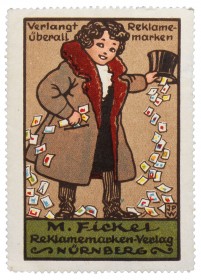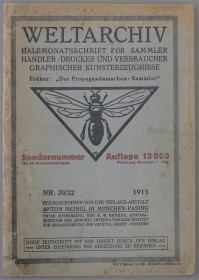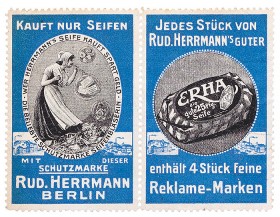“Poster stamps?” A short pause, a puzzled look. “And… what are poster stamps?” This was more or less the reaction of every one of my friends and acquaintances when I told them these last months about ‘what I’m working on at the museum right now’. Namely, an exhibition on poster stamps.

Poster stamp from the publisher M. Fickel © Jewish Museum Berlin, photo: Jens Ziehe, gift of Peter-Hannes Lehmann
Poster stamps, I would answer, are small promotional pictures, a little bigger than stamps. They were used as advertisements for products and stores just about exactly a hundred years ago. Some of the stamps were designed by well-known artists like Lucian Bernhard and people would collect them, particularly children.
I didn’t know much more than that about these poster stamps before I started researching for our cabinet exhibition “Pictures Galore and Collecting Mania – Advertising in Miniature”. The show begins on 4. December, 2014 and lasts until 31. May, 2015 at the Rafael Roth Learning Center. To learn more about the relevance that the stamps had before World War I, I began reading contemporary advertising manuals and magazines.
At first I found relatively little on the subject, since the little images apparently played a secondary role to other forms of modern publicity, such as placards and newspaper advertisements.

Poster stamp collectors’ magazine „Weltarchiv”, published from 1913 to 1914 © Jewish Museum Berlin, photo: Jens Ziehe, gift of Peter-Hannes Lehmann
I had more success with periodicals: from trade journals for the printing industry to publications with a much wider readership, poster stamps were a massive phenomenon for a short time between 1912 and 1914 and were, accordingly, hotly debated. “Is it commendable that companies and shop owners are printing and distributing poster stamps, sometimes by the million, and widely varying in quality?” “Is collecting poster stamps a rational educational activity for children who get caught up momentarily in an absolute collecting craze?” And “Is the poster stamp even an effective means of advertising?” The arguments that got debated back and forth at the time, about the existential significance or folly of poster stamps, sound remarkably similar to discussions about the effect on young people of using smart phones, today.
Poster stamps were primarily handed out to customers as a free perk, to encourage them to patronize particular stores, to purchase particular products, or simply to buy larger quantities (two bars of soap instead of one). This method worked especially well with parents, since children were evidently ‘leading the way while out, running the show at home’ – influencing family shopping trips as much a century ago as today, if outraged contemporary reports are to be believed. And the shops that handed out the stamps enjoyed broad popularity among the population of under-aged collectors.

Two poster stamps from the Rud. Hermann Company
© Jewish Museum Berlin, photo: Jens Ziehe, gift of Peter-Hannes Lehmann
So I can now tell my friends that poster stamps are just the turn of the last century’s plastic dinosaurs in cornflakes boxes, animal collector cards at chain stores, or bonus card from the pharmacy. Except that the poster stamps often actually featured little artworks that still merit attention a hundred years later, as part of a real museum exhibition and just for fun too.
Mariette Franz, Media